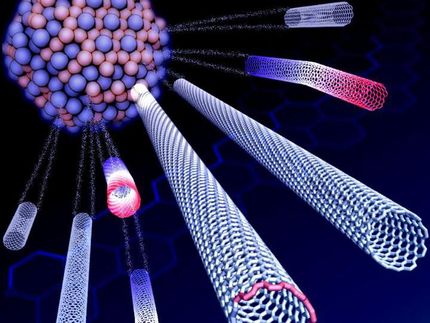Electron Rivers
Usually, the movement of electrons in a real material is rather different from the flow of water in a river. However, in extraordinary materials like the metal oxide PdCoO2, “electron rivers” can exist, as predicted theoretically over fifty years ago and now demonstrated by scientists from the MPI CPfS.

One of the created “electron rivers”. The flow takes place along the purple channel, and is studied using instruments attached to the blue, red, green and gold-coloured parts.
MPI CPfS
Although one might think that when there is an electric current in a metal, the electrons flow like water would in a pipe, that is actually not the case. Their motion is impeded because they bounce off the atoms that make up the metallic crystal, and the flow process is not nearly as interesting as the ones that we can see at play any time we sit next to a river. For ‘electron rivers’ to exist, one needs to find extraordinary materials in which the collisions with the host atoms are thousands of times weaker than usual. Although this possibility, known as ‘electronic hydrodynamics’, was predicted theoretically over fifty years ago, it has taken until now to reach the new regime in a bulk material. The groups of Philip Kim at Harvard and Andre Geim at Manchester worked on graphene, but the contribution from the Mackenzie and Moll groups from the Max Planck Institute for Chemical Physics of Solids Dresden was based on an oxide metal.
Our material of choice, PdCoO2, has an astonishingly high electrical conductivity, making it possible to look for hydrodynamic effects. To reveal their presence, we sculpted successively narrower channels, and studied how easily the electrons could flow through them. By combining our results with a special theory that is able to model hydrodynamic effects, we were able to show that we had indeed created the long-predicted electron rivers. The research opens new frontiers in research into electron behavior in ultra-pure materials. The richness seen in the flow of water might be observable in the flow of electrons, and some of this richness might one day also lead to the invention of new electronic devices. We hope to play a leading role in these developments.
The research at the Max Planck Institute for Chemical Physics of Solids (MPI CPfS) in Dresden aims to discover and understand new materials with unusual properties. In close cooperation, chemists and physicists (including chemists working on synthesis, experimentalists and theoreticians) use the most modern tools and methods to examine how the chemical composition and arrangement of atoms, as well as external forces, affect the magnetic, electronic and chemical properties of the compounds. New quantum materials, physical phenomena and materials for energy conversion are the result of this interdisciplinary collaboration.
Original publication
Other news from the department science

Get the chemical industry in your inbox
By submitting this form you agree that LUMITOS AG will send you the newsletter(s) selected above by email. Your data will not be passed on to third parties. Your data will be stored and processed in accordance with our data protection regulations. LUMITOS may contact you by email for the purpose of advertising or market and opinion surveys. You can revoke your consent at any time without giving reasons to LUMITOS AG, Ernst-Augustin-Str. 2, 12489 Berlin, Germany or by e-mail at revoke@lumitos.com with effect for the future. In addition, each email contains a link to unsubscribe from the corresponding newsletter.

























































